1.1 Discussion
The first consonants (व्यंजन vyañjan) in the Devanāgarī alphabet are known as the velar (कंठ्य kaṇṭhya) series. That is, they are all articulated at the back of the mouth, at the structure known as the soft palate or velum. As described above, each (plosive) consonant series follows a regular pattern: voiceless unaspirated, voiceless aspirated, voiced unaspirated, voiced aspirated, and nasal. The chart below describes each letter in this series and the sound it makes.
Devanāgarī character + stroke order |
Transliteration |
IPA symbol |
Sounds like |
Notes |
|
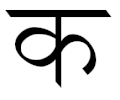 |
k | k | k in “skip” | voiceless, unaspirated | |
| click to hear
|
|||||
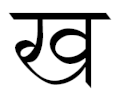 |
kh | kʰ | k in “kind” | voiceless, aspirated | |
| click to hear | |||||
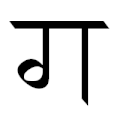 |
g | g | g in get | voiced, unaspirated | |
| click to hear | |||||
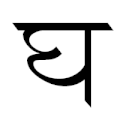 |
gh | ɡʱ | g above with a breathy puff of air | voiced, aspirated; try saying the middle sound in “big head” several times, then isolate the middle part | |
| click to hear | |||||
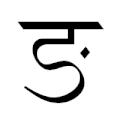 |
ṅ | ŋ | ng in “sing” | rarely used; note that the basic shape of this letter is the same as that of ḍ (), with the addition of a small dot (bindu) to the right of the letter | |
| click to hear | |||||
There are three important points that will need to be kept in mind moving forward. First, every consonant in Devanāgarī has an implied inherent vowel, short a (अ), which sounds like u in the English word “up”. This inherent vowel is generally not pronounced at the ends of words. Therefore, the word घघ is read as ghagh (not ghagha or the unpronounceable ghgh). The inherent vowel will always be pronounced unless another vowel marking is present, except at the end of the word. In the coming lessons, we will learn more about how to combine consonants and vowels.
The second and third points have to do with the horizontal line found at the top of most Devanāgarī letters. In Hindi, this is called the शिरोरेखा śirōrēkhā. First, note that this top line is generally drawn last. Moreover, when writing a word with more than one character, the top line is drawn after all the remaining components have been written. Thus, if writing the word घघ ghagh we used in the example above, the order would go as follows:
| 1. |  |
| 2. | 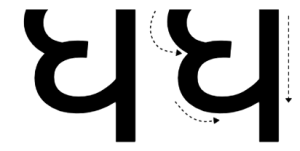 |
| 3. | 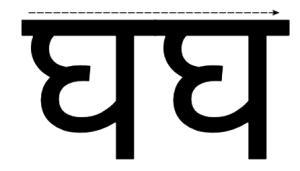 |
